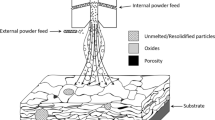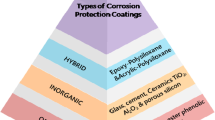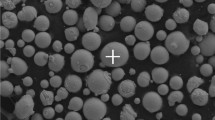Abstract
The lubrication of pure MoS2 coating for the application in air environment has been commonly limited owing to its loose structure, low hardness, and high humidity sensitivity. To overcome such drawbacks, MoS2/Pb–Ti composite and multilayer coatings were deposited by unbalanced magnetron sputtering system. And subsequently, the oxidation resistance and tribological properties of such MoS2-based coatings were studied after 30 days of exposure under different temperatures (ranging from 20 to 80 °C) with the relative humidity of 80% (RH 80%). We found that pure MoS2 showed poor oxidation resistance after 30 days of exposure and presented high and fluctuating coefficient of friction (COF), leading to the early failure of the coating. In contrast, the oxidation resistance of MoS2 was improved significantly by Pb–Ti co-doping and multilayer design. What is more, the low COF and wear rate were also obtained from the composite and multilayer coatings even after 30 days of exposure at 80 °C, RH 80%, which was related to the compact structure and higher values of hardness to elastic modulus (H/E). More importantly, the high density of interfaces and a relatively strong (002) preferred orientation in the multilayer coating were beneficial to reduce the wear and COF, causing better tribological performance than others.









Similar content being viewed by others
References
Donnet C, Erdemir A (2004) Solid lubricant coatings: recent developments and future trends. Tribol Lett 17:389–397
Chhowalla M, Amaratunga GAJ (2000) Thin films of fullerene-like MoS2 nanoparticles with ultra-low friction and wear. Nature 407:164–167
Wang P, Qiao L, Xu J, Li WX, Liu WM (2015) Erosion mechanism of MoS2-based films exposed to atomic oxygen environments. ACS Appl Mat Interfaces 7:12943–12950
Winer W (1967) Molybdenum disulfide as a lubricant: a review of the fundamental knowledge. Wear 10:422–452
Steinmann M, Müller A, Meerkamm H (2004) A new type of tribological coating for machine elements based on carbon, molybdenum disulphide and titanium diboride. Tribol Int 37:879–885
Polcar T, Cavaleiro A (2011) Review on self-lubricant transition metal dichalcogenide nanocomposite coatings alloyed with carbon. Surf Coat Technol 206:686–695
Renevier NM, Hamphire J, Fox VC, Witts J, Allen T, Teer DG (2001) Advantages of using self-lubricating, hard, wear-resistant MoS2-based coatings. Surf Coat Technol 142:67–77
Voevodin AA, Fitz TA, Hu JJ, Zabinski JS (2002) Nanocomposite tribological coatings with chameleon surface adaptation. J Vac Sci Technol, A 20:1434–1444
Scharf TW, Kotula PG, Prasad SV (2010) Friction and wear mechanisms in MoS2/Sb2O3/Au nanocomposite coatings. Acta Mater 58:4100–4109
Wang DY, Chang CL, Chen ZY, Ho WY (1999) Microstructural and tribological characterization of MoS2–Ti composite solid lubricating films. Surf Coat Technol 120:629–635
Savan A, Simmonds MC, Huang Y, Constable CP, Creasey S, Gerbig Y, Haefke H, Lewis DB (2005) Effects of temperature on the chemistry and tribology of co-sputtered MoSx-Ti composite thin films. Thin Solid Films 489:137–144
Renevier NM, Fox VC, Teer DG, Hampshire J (2000) Coating characteristics and tribological properties of sputter-deposited MoS2/metal composite coatings deposited by closed field unbalanced magnetron sputter ion plating. Surf Coat Technol 127:24–37
Arslan E, Bülbül F, Alsaran A, Celik A, Efeoglu I (2005) The effect of deposition parameters and Ti content on structural and wear properties of MoS2–Ti coatings. Wear 259:814–819
Wang X, Xing Y, Ma S, Zhang X, Xu K, Teer DG (2007) Microstructure and mechanical properties of MoS2/titanium composite coatings with different titanium content. Surf Coat Technol 201:5290–5293
Qin X, Ke P, Wang A, Kim KH (2013) Microstructure, mechanical and tribological behaviors of MoS2-Ti composite coatings deposited by a hybrid HIPIMS method. Surf Coat Technol 228:275–281
Banerji A, Bhowmick S, Alpas AT (2017) Role of temperature on tribological behaviour of Ti containing MoS2 coating against aluminum alloys. Surf Coat Technol 314:2–12
Wahl KJ, Dunn DN, Singer IL (1999) Wear behavior of Pb–Mo–S solid lubricating coatings. Wear 230:175–183
Dvorak SD, Wahl KJ, Singer IL (2007) In situ analysis of third body contributions to sliding friction of a Pb–Mo–S coating in dry and humid air. Tribol Lett 28:263–274
Li H, Zhang G, Wang L (2016) Low humidity-sensitivity of MoS2/Pb nanocomposite coatings. Wear 350:1–9
Scharf TW, Goeke RS, Kotula PG, Prasad SV (2013) Synthesis of Au–MoS2 nanocomposites: thermal and friction-induced changes to the structure. ACS Appl Mat Interfaces 5:11762–11767
Singh H, Mutyala KC, Evans RD, Doll GL (2015) An investigation of material and tribological properties of Sb2O3/Au-doped MoS2 solid lubricant films under sliding and rolling contact in different environments. Surf Coat Technol 284:281–289
Ma G, Xu B, Wang H, Wang X, Li G, Zhang S (2013) Research on the microstructure and space tribology properties of electric-brush plated Ni/MoS2–C composite coating. Surf Coat Technol 221:142–149
Mikhailov S, Savan A, Pflüger E, Knoblauch L, Hauert R, Simmonds M, Van Swygenhoven H (1998) Morphology and tribological properties of metal (oxide)-MoS2 nanostructured multilayer coatings. Surf Coat Technol 105:175–183
Ding XZ, Zeng XT, He XY, Chen Z (2010) Tribological properties of Cr- and Ti-doped MoS2 composite coatings under different humidity atmosphere. Surf Coat Technol 205:224–231
Su YL, Kao WH (2003) Tribological behaviour and wear mechanism of MoS2–Cr coatings sliding against various counterbody. Tribol Int 36:11–23
Zhang X, Xu J, Chai L, He T, Yu F, Wang P (2017) Carbon and nitrogen co-doping self-assembled MoS2 multilayer films. Appl Surf Sci 406:30–38
Rabinowicz E (1971) The determination of the compatibility of metals through static friction tests. ASLE Trans 14:198–205
Ren S, Li H, Cui M, Wang L, Pu J (2017) Functional regulation of Pb–Ti/MoS2 composite coatings for environmentally adaptive solid lubrication. Appl Surf Sci 401:362–372
Hilton MR, Bauer R, Didziulis SV, Dugger MT, Keem JM, Scholhamer J (1992) Structural and tribological studies of MoS2 solid lubricant films having tailored metal-multilayer nanostructures. Surf Coat Technol 53:13–23
Simmonds M, Savan A, Van Swygenhoven H (1998) Structural, morphological, chemical and tribological investigations of sputter deposited MoS2/metal multilayer coatings. Surf Coat Technol 108:340–344
Zhang P, Fang Y, Dai S, Fu Y, Zhang M, Huang M, Hu J (2016) Preparation and characterization of MoS2–TiL/MoS2–TiH nano multilayer coating with excellent wear properties. MaterLett 173:35–38
Watanabe S, Noshiro J, Miyake S (2004) Tribological characteristics of WS2/MoS2 solid lubricating multilayer films. Surf Coat Technol 183:347–351
Li H, Xie M, Zhang G, Fan X, Li X, Zhu M, Wang L (2018) Structure and tribological behavior of Pb–Ti/MoS2 nanoscaled multilayer films deposited by magnetron sputtering method. Appl Surf Sci 435:48–54
Shang K, Zheng S, Ren S, Pu J, He D, Liu S (2018) Improving the tribological and corrosive properties of MoS2-based coatings by dual-doping and multilayer construction. Appl Surf Sci 437:233–244
Jia J, Niu YS, Wu J, Yu ZM (2014) Improvement of properties of TiN coating by optimising microstructural design. Surf Eng 30:36–40
Teer DG, Hampshire J, Fox V, Bellido-Gonzalez V (1997) The tribological properties of MoS2/metal composite coatings deposited by closed field magnetron sputtering. Surf Coat Technol 94:572–577
Zhang X, Vitchev RG, Lauwerens W, Stals L, He J, Celis JP (2001) Effect of crystallographic orientation on fretting wear behaviour of MoSx coatings in dry and humid air. Thin Solid Films 396:69–77
Fleischauer PD (1984) Effects of crystallite orientation on environmental stability and lubrication properties of sputtered MoS2 thin films. ASLE Trans 27:82–88
Wang X, Zhang Z, Chen Y, Qu Y, Lai Y, Li J (2014) Morphology-controlled synthesis of MoS2 nanostructures with different lithium storage properties. J Alloys Compd 600:84–90
Wu Y, Li H, Ji L, Ye Y, Chen J (2013) A long-lifetime MoS2/a-C: H nanoscale multilayer film with extremely low internal stress. Surf Coat Technol 236:438–443
Gao X, Fu Y, Jiang D, Wang D, Xu S, Liu W, Weng L, Yang J, Sun J, Hu M (2018) Constructing WS2/MoS2 nano-scale multilayer film and understanding its positive response to space environment. Surf Coat Technol 353:8–17
Naumkin AV, Kraut-Vass A, Gaarenstroom SW, Powell CJ (2003) NIST X-ray photoelectron spectroscopy database, version 3.3. National Institute of Standards and Technology, USA. https://doi.org/10.18434/T4T88K
Bertóti I, Mohai M, Renevier NM, Szilágyi E (2000) XPS investigation of ion beam treated MoS2-Ti composite coatings. Surf Coat Technol 125:173–178
Pu J, Ren S, Lu Z, Wang L (2016) A feasible multilayer structure design for solid lubricant coatings in a lunar environment. RSC Adv 6:65504–65517
Khadem M, Penkov OV, Yang HK, Kim DE (2017) Tribology of multilayer coatings for wear reduction: a review. Friction 5:248–262
Martinez E, Sanjines R, Karimi A, Esteve J, Lévy F (2004) Mechanical properties of nanocomposite and multilayered Cr–Si–N sputtered thin films. Surf Coat Technol 180:570–574
Teer DG (2001) New solid lubricant coatings. Wear 251:1068–1074
Flores M, Muhl S, Huerta L, Andrade E (2005) The influence of the period size on the corrosion and the wear abrasion resistance of TiN/Ti multilayers. Surf Coat Technol 200:1315–1319
Musil J (2000) Hard and superhard nanocomposite coatings. Surf Coat Technol 125:322–330
Acknowledgements
The authors are grateful for financial support from the National Science Fund for Distinguished Young Scholars of China (Grant No. 51825505) and the National Natural Science Foundation of China (Grant Nos. U1737214 and 51775539) and the Natural Science Foundation of Zhejiang Province of China (Grant No. LZ17E050004).
Author information
Authors and Affiliations
Corresponding authors
Ethics declarations
Conflict of interest
The authors declare that they have no conflicts of interest to declare.
Additional information
Publisher's Note
Springer Nature remains neutral with regard to jurisdictional claims in published maps and institutional affiliations.
Electronic supplementary material
Below is the link to the electronic supplementary material.
Rights and permissions
About this article
Cite this article
Ren, S., Shang, K., Cui, M. et al. Structural design of MoS2-based coatings toward high humidity and wide temperature. J Mater Sci 54, 11889–11902 (2019). https://doi.org/10.1007/s10853-019-03754-8
Received:
Accepted:
Published:
Issue Date:
DOI: https://doi.org/10.1007/s10853-019-03754-8




